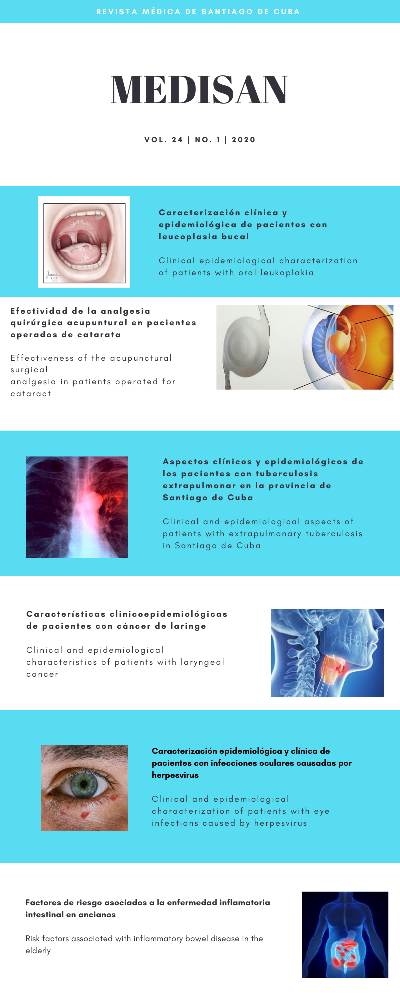Pregnant women with altered pulsatility index in Doppler echography
Keywords:
pregnancy, pre-eclampsia, eclampsia, fetal growth retardation, pulsatile flow, Doppler ultrasonography.Abstract
Introduction: The Doppler echography of the uterine arteries is a technique suggested to predict the risk of pre-eclampsia, the intrauterine growth retardation and other adverse perinatal disorders.
Objectives: To determine the frequency of pregnant women with disorder in the uterine arteries during the first trimester and to identify the pre-eclampsia/eclampsia presence, as well as their main clinical characteristics.
Methods: A descriptive and longitudinal study of 168 pregnant women in the first trimester of pregnancy, belonging to the Tercer Frente municipality in Santiago de Cuba was carried out, they were evaluated by investigation of Genetics in Cruce de los Baños Teaching Polyclinic from April to November, 2018. To determine the pulsatility index of the uterine arteries, a Doppler echography was carried out.
Results: In the case material 16 patients presented this parameter altered and just 3 pregnant women presented pre-eclampsia, for 18.7 %; the average age of these last ones was of 29 years and 2 were nonparous (66.6 %). Regarding the pulsatility index, the average was of 2.5.
Conclusions: There was a close follow up of the patients with pathological results, until the childbirth, and the importance of studying the pulsatility index of the uterine arteries in the first trimester of the pregnancy, mainly in the nonparous, was emphasized.
Downloads
References
2. Bracamonte-Peniche J, López-Bolio V, Mendicuti-Carrillo M, Ponce-Puerto JM, Sanabrais-López MJ, Méndez-Domínguez N. Características clínicas y fisiológicas del síndrome de Hellp. Revista Biomédica. 2018 [citado 15/06/2019];29(2). Disponible en: https://www.medigraphic.com/pdfs/revbio/bio-2018/bio182b.pdf
3. Reverter Calatayud JC, Vicente García V. Enfermedades de la Hemostasia. En: Farreras-Rozman. Medicina Interna, 18 ed. Madrid: Elsevier; 2017. p. 1700.
4. Cararach Ramoneda V, Botet Mussons F. Preeclampsia. Eclampsia y síndrome HELLP. En: Protocolos Diagnóstico de la AEP; Neonatología. Barcelona: Institut Clínic de Ginecología, Obstetricia y Neonatología; 2008 [citado 15/06/2019]. Disponible en: https://www.aeped.es/sites/default/files/documentos/16_1.pdf
5. Roberge S, Odibo AO, Bujold E. Aspirinfor the prevention of preeclampsia and intrauterine growth restriction. Clin Lab Med. 2016;36(2):319-29.
6. Nápoles Méndez D. Actualización sobre las bases fisiopatológicas de la preeclampsia. MEDISAN. 2015 [citado 19/06/2019];18(8). Disponible en: http://scielo.sld.cu/scielo.php?script=sci_arttext&pid=S1029-30192015000800012
7. Kane SC, Dennis AT. Doppler Assessment of Uterine Blood Flow in Pre-eclampsia: A Review. Hypertension in Pregnancy. 2015; 34(4): 400-21.
8. Hantoushzadeh S, Torabi S, Sheikh M, Fattahi Masrour F, Bateni Zhoobin H, Shamshirsaz AA. 709: Uterine artery Doppler ultrasound predictor of adverse pregnancy outcomes. AJOG. 2017; 216(1Sup):414–5.
9. Yu CK, Khouri O, Onwudiwe N, Spiliopoulos Y, Nicolaides KH. Maternal uterine artery Doppler in the first and second trimesters as screening method for hypertensive disorders and adverse perinatal outcomes in low-risk pregnancies. Obstet Gynecol Sci. 2016;59(5):347–56.
10. Carvajal JA, Ralph C. Manual de Obstetricia y Ginecología. 9 ed. Santiago de Chile: Pontificia Universidad Católica de Chile; 2018 [citado 19/06/2019]. Disponible en: https://medicina.uc.cl/wp-content/uploads/2018/08/Manual-Obstetricia-y-Ginecologi%CC%81a-2018.pdf
11. Torres Ruiz S. Factores de riesgo para preeclampsia en un hospital de la amazonia Peruana. CASUS. 2016 [citado 19/06/2019];1(1):18-26. Disponible en: https://casus.ucss.edu.pe/index.php/casus/article/view/11/6
12. Cortés Yepes H. Doppler de arterias uterinas en el primer trimestre del embarazo para la detección de los trastornos hipertensivos asociados con el embarazo: estudio de cohorte. Bogotá, Colombia. Rev Colomb Obstet Ginecol. 2009;60:328-33.
13. Huertas Tacchino E, Rodríguez L, Sotelo F, Ingar J, Limay A, Castillo W, et al. Valor predictivo del índice de pulsatilidad promedio de las arterias uterinas en la predicción de preeclampsia en las gestantes entre 11 y 14 semanas, Instituto Nacional Materno Perinatal. Rev Peru Epidemiol. 2012;16(1):18-22.
14. Guibovich Mesinas AA, Fang Marino AR. Ultrasonografia doppler de arterias uterinas entre las 11 a 14 semanas de edad gestacional, como predictor de preeclampsia. Rev Horiz Med. 2012 [citado 19/06/2019];12(2). Disponible en: https://www.mimp.gob.pe/webs/mimp/sispod/pdf/271.pdf
15. González Rodríguez J, Gómez Marco A. Universidad Nacional de Colombia, Doppler de arterias uterinas en la predicción de trastornos hipertensivos del embarazo en un grupo de pacientes que asisten a tamizaje integrado en semana 11- 13 6/7. En una unidad de alto riesgo obstétrico [tesis de grado]. Bogotá: Universidad Nacional de Colombia; 2013 [citado 19/06/2019]. Disponible en: http://bdigital.unal.edu.co/11515/1/05598755.2013.pdf
16. García García B. Utopía: Eficacia del Doppler de las arterias uterinas en el segundo trimestre y control exhaustivo de la gestación para la prevención de malos resultados perinatales. Estudio randomizado [tesis doctoral]. Barcelona: Universitat Autònoma de Barcelona; 2015 [citado 19/06/2019]. Disponible en: https://www.tesisenred.net/bitstream/handle/10803/325417/bgg1de1.pdf?sequence=1&isAllowed=y
17. Carvajal JA, Ralph C. Manual de Obstetricia y Ginecología. 9 ed. Santiago de Chile: Pontificia Universidad Católica de Chile; 2019.
Published
How to Cite
Issue
Section
License
All the articles can be downloaded or read for free. The journal does not charge any amount of money to the authors for the reception, edition or the publication of the articles, making the whole process completely free. Medisan has no embargo period and it is published under the license of Creative Commons, International Non Commercial Recognition 4.0, which authorizes the copy, reproduction and the total or partial distribution of the articles in any format or platform, with the conditions of citing the source of information and not to be used for profitable purposes.






